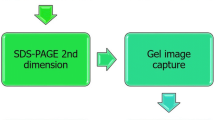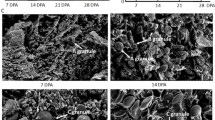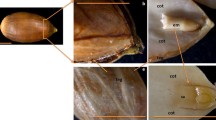Abstract
Miscanthus sinensis is a promising bioenergy crop; however, its genome is poorly represented in sequence databases. As an initial step in the comprehensive analysis of the M. sinensis proteome, we report a reference 2-DE protein map of the leaf. A total of 316 protein spots were excised from the gels, digested with trypsin and subjected to matrix-assisted laser desorption/ionization-time of flight mass spectrometry (MALDI-TOF MS) or MALDI-TOF/TOF MS. Two hundred and thirty-two protein spots were identified, which are involved in a variety of cellular functions through distinct metabolic pathways. Functional annotation of the proteins revealed a nearly complete C3 and C4 cycle, starch and sugar synthesis pathway, glycolysis pathway, a significant portion of the pentose phosphate pathway, and many enzymes involved in secondary metabolism such as flavonoid/isoflavonoid, kaurene, chalcone, sesquiterpene and lignin biosynthesis. Other proteins belong to primary metabolism, transcription, protein synthesis, protein destination/storage, disease/defense, cell growth/division, transportation and signal transduction. To test the applicability of the constructed map, we studied the effect of heat stress on M. sinensis leaf proteome. Twenty-five protein spots were upregulated, five were newly induced and twenty-five spots were downregulated by heat treatment. The differentially accumulated proteins were involved in photosynthesis, energy metabolism, gene transcription, protein kinases and phosphatases, signal transduction, protein synthesis and heat shock responses. C4-specific pyruvate orthophosphate dikinase, Rubisco large subunit, Rubisco activase and some associated proteins were upregulated during heat stress and tend to restore upon recovery. Identification of these proteins provides some important clues regarding the way M. sinensis copes with hot climate. This work represents the first extensive proteomic description of M. sinensis and provides a reference map and heat-responsive candidates for future molecular and physiological studies of this bioenergy crop.








Similar content being viewed by others
Abbreviations
- 2-D PAGE:
-
Two dimensional polyacrylamide gel electrophoresis
- DTT:
-
Dithiothreitol
- HSP:
-
Heat-shock protein
- IPG:
-
Immobilized pH gradient
- MALDI-TOF MS:
-
Matrix-assisted laser desorption/ionization-time of flight mass spectrometry
- NGS:
-
Next-generation sequencing
- PCD:
-
Programmed cell death
- PMF:
-
Peptide mass fingerprinting
- PPDK:
-
Pyruvate phosphate dikinase
References
Abril N, Gion J-M, Kerner R, Müller-Starck G, Cerrillo RMN, Plomion C, Renaut J, Valledor L, Jorrin-Novo JV (2011) Proteomics research on forest trees, the most recalcitrant and orphan plant species. Phytochemistry 72:1219–1242
Bevan M, Bancroft I, Bent E, Love K, Goodman H, Dean C, Bergkamp R et al (1998) Analysis of 1.9 Mb of contiguous sequence from chromosome 4 of Arabidopsis thaliana. Nature 391:485–488
Brune A, Urbach W, Dietz K-J (1995) Differential toxicity of heavy metals is partly related to a loss of preferential extraplasmic compartmentation: a comparison of Cd-, Mo-, Ni- and Zn-stress. New Phytol 129:403–409
Bukhov N, Dzhibladze T, Egorova E (2005) Elevated temperatures inhibit ferredoxin-dependent cyclic electron flow around photosystem I. Russ J Plant Physiol 52:578–583
Cánovas FM, Dumas-Gaudot E, Recorbet G, Jorrin J, Mock H-P, Rossignol M (2004) Plant proteome analysis. Proteomics 4:285–298
Carpentier SC, Witters E, Laukens K, Onckelen HV, Swennen R, Panis B (2007) Banana (Musa spp.) as a model to study the meristem proteome: acclimation to osmotic stress. Proteomics 7:92–105
Carpentier SC, Panis B, Vertommen A, Swennen R, Sergeant K, Renaut J, Laukens K, Witters E, Samyn B, Devreese B (2008) Proteome analysis of non-model plants: a challenging but powerful approach. Mass Spectrom Rev 27:354–377
Chardonnens AN, Koevoets PLM, van Zanten A, Schat H, Verkleij JAC (1999) Properties of enhanced tonoplast zinc transport in naturally selected zinc-tolerant Silene vulgaris. Plant Physiol 120:779–786
Christian DG, Yates NE, Riche AB (2005) Establishing Miscanthus sinensis from seed using conventional sowing methods. Ind Crop Prod 21:109–111
Clifton-Brown JC, Lewandowski I, Bangerth F, Jones MB (2002) Comparative responses to water stress in stay-green, rapid- and slow senescing genotypes of the biomass crop, Miscanthus. New Phytol 154:335–345
Clifton-Brown J, Chiang Y-C, Hodkinson T (2008) Miscanthus: genetic resources and breeding potential to enhance bioenergy production. In: Vermerris W (ed) Genetic improvement of bioenergy crops. Springer, New York, pp 273–294
Crafts-Brandner SJ, Salvucci ME (2000) Rubisco activase constrains the photosynthetic potential of leaves at high temperature and CO2. Proc Natl Acad Sci USA 97:13430–13435
Crafts-Brandner SJ, Salvucci ME (2002) Sensitivity of photosynthesis in a C4 plant, maize, to heat stress. Plant Physiol 129:1773–1780
Dixon DP, Skipsey M, Edwards R (2010) Roles for glutathione transferases in plant secondary metabolism. Phytochemistry 71:338–350
Donnelly BE, Madden RD, Ayoubi P, Porter DR, Dillwith JW (2005) The wheat (Triticum aestivum L.) leaf proteome. Proteomics 5:1624–1633
Fäldt J, Arimura G-i, Gershenzon J, Takabayashi J, Bohlmann J (2003) Functional identification of AtTPS03 as (E)-β-ocimene synthase: a monoterpene synthase catalyzing jasmonate- and wound-induced volatile formation in Arabidopsis thaliana. Planta 216:745–751
Farinati S, DalCorso G, Bona E, Corbella M, Lampis S, Cecconi D, Polati R, Berta G, Vallini G, Furini A (2009) Proteomic analysis of Arabidopsis halleri shoots in response to the heavy metals cadmium and zinc and rhizosphere microorganisms. Proteomics 9:4837–4850
Farrell AD, Clifton-Brown JC, Lewandowski I, Jones MB (2006) Genotypic variation in cold tolerance influences the yield of Miscanthus. Ann Appl Biol 149:337–345
Furbank RT, Chitty JA, Jenkins CLD, Taylor WC, Trevanion SJ, Caemmerer Sv, Ashton AR (1997) Genetic manipulation of key photosynthetic enzymes in the C4 plant Flaveria bidentis. Funct Plant Biol 24:477–485
Galván JV, Valledor L, Fernandez RG, Cerrillo RMN, Jorrín-Novo JV (2012) Proteomic analysis of Holm oak (Quercus ilex subsp. ballota [Desf.] Samp.) pollen. J Proteomics 75:2736–2744
Gammulla CG, Pascovici D, Atwell BJ, Haynes PA (2010) Differential metabolic response of cultured rice (Oryza sativa) cells exposed to high- and low-temperature stress. Proteomics 10:3001–3019
Giavalisco P, Nordhoff E, Kreitler T, Klöppel K-D, Lehrach H, Klose J, Gobom J (2005) Proteome analysis of Arabidopsis thaliana by two-dimensional gel electrophoresis and matrix-assisted laser desorption/ionisation-time of flight mass spectrometry. Proteomics 5:1902–1913
Guy C, Kaplan F, Kopka J, Selbig J, Hincha DK (2008) Metabolomics of temperature stress. Physiol Plant 132:220–235
Harrison EP, Willingham NM, Lloyd JC, Raines CA (1997) Reduced sedoheptulose-1,7-bisphosphatase levels in transgenic tobacco lead to decreased photosynthetic capacity and altered carbohydrate accumulation. Planta 204:27–36
Heaton EA, Dohleman FG, Miguez AF, Juvik JA, Lozovaya V, Widholm J, Zabotina OA, McIsaac GF, David MB, Voigt TB, Boersma NN, Long SP (2010) Miscanthus: a promising biomass crop. Adv Bot Res 56:75–137
Hu X, Li Y, Li C, Yang H, Wang W, Lu M (2010) Characterization of small heat shock proteins associated with maize tolerance to combined drought and heat stress. J Plant Growth Regul 29:455–464
Jeter CR, Tang W, Henaff E, Butterfield T, Roux SJ (2004) Evidence of a novel cell signaling role for extracellular adenosine triphosphates and diphosphates in Arabidopsis. Plant Cell 16:2652–2664
Jorrín-Novo JV, Maldonado AM, Echevarría-Zomeño S, Valledor L, Castillejo MA, Curto M, Valero J, Sghaier B, Donoso G, Redondo I (2009) Plant proteomics update (2007–2008): second-generation proteomic techniques, an appropriate experimental design, and data analysis to fulfill MIAPE standards, increase plant proteome coverage and expand biological knowledge. J Proteomics 72:285–314
Katam R, Basha SM, Suravajhala P, Pechan T (2010) Analysis of peanut leaf proteome. J Proteome Res 9:2236–2254
Kim S-Y, Sivaguru M, Stacey G (2006) Extracellular ATP in plants: visualization, localization, and analysis of physiological significance in growth and signaling. Plant Physiol 142:984–992
Kim K-H, Alam I, Kim Y-G, Sharmin S, Lee K-W, Lee S-H, Lee B-H (2012) Overexpression of a chloroplast-localized small heat shock protein OsHSP26 confers enhanced tolerance against oxidative and heat stresses in tall fescue. Biotechnol Lett 34:371–377
Kosová K, Vítámvás P, Prášil IT, Renaut J (2011) Plant proteome changes under abiotic stress—contribution of proteomics studies to understanding plant stress response. J Proteomics 74:1301–1322
Kutchan T, Dixon RA (2005) Physiology and metabolism: secondary metabolism: nature’s chemical reservoir under deconvolution. Curr Opin Plant Biol 8:227–229
Lafferty J, Lelley T (1994) Cytogenetic studies of different Miscanthus species with potential for agricultural use. Plant Breeding 113:246–249
Leborgne-Castel N, Jelitto-Van Dooren EPWM, Crofts AJ, Denecke J (1999) Overexpression of BiP in tobacco alleviates endoplasmic reticulum stress. Plant Cell 11:459–470
Lee D-G, Ahsan N, Lee S-H, Kang KY, Bahk JD, Lee I-J, Lee B-H (2007) A proteomic approach in analyzing heat-responsive proteins in rice leaves. Proteomics 7:3369–3383
Lee D-G, Ahsan N, Lee S-H, Lee JJ, Bahk JD, Kang KY, Lee B-H (2009) Chilling stress-induced proteomic changes in rice roots. J Plant Physiol 166:1–11
Lewandowski I, Clifton-Brown JC, Andersson B, Basch G, Christian DG, Jorgensen U, Jones MB, Riche AB, Schwarz KU, Tayebi K, Teixeira F (2003) Environment and harvest time affects the combustion qualities of Miscanthus genotypes. Agron J 95:1274–1280
Li X-J, Yang M-F, Zhu Y, Liang Y, Shen S-H (2011) Proteomic analysis of salt stress responses in rice shoot. J Plant Biol 54:384–395
Lin C, Shalitin D (2003) Cryptochrome structure and signal transduction. Annu Rev Plant Biol 54:469–496
Liska AJ, Shevchenko A (2003) Expanding the organismal scope of proteomics: cross-species protein identification by mass spectrometry and its implications. Proteomics 3:19–28
Lowry OH, Rosebrough NJ, Farr AL, Randall RJ (1951) Protein measurement with the folin phenol reagent. J Biol Chem 193:265–275
Lund P (1994) The chaperonin cycle and protein folding. BioEssays 16:229–231
Mata J, Marguerat S, Bähler J (2005) Post-transcriptional control of gene expression: a genome-wide perspective. Trends Biochem Sci 30:506–514
Méchin V, Balliau T, Château-Joubert S, Davanture M, Langella O, Négroni L, Prioul J-L, Thévenot C, Zivy M, Damerval C (2004) A two-dimensional proteome map of maize endosperm. Phytochemistry 65:1609–1618
Meiri D, Breiman A (2009) Arabidopsis ROF1 (FKBP62) modulates thermotolerance by interacting with HSP90.1 and affecting the accumulation of HsfA2-regulated sHSPs. Plant J 59:387–399
Nakamoto H, Suzuki N, Roy SK (2000) Constitutive expression of a small heat-shock protein confers cellular thermotolerance and thermal protection to the photosynthetic apparatus in cyanobacteria. FEBS Lett 483:169–174
Oliver RJ, Finch JW, Taylor G (2009) Second generation bioenergy crops and climate change: a review of the effects of elevated atmospheric CO2 and drought on water use and the implications for yield. GCB Bioenergy 1:97–114
Paul MJ, Knight JS, Habash D, Parry MAJ, Lawlor DW, Barnes SA, Loynes A, Gray JC (1995) Reduction in phosphoribulokinase activity by antisense RNA in transgenic tobacco: effect on CO2 assimilation and growth in low irradiance. Plant J 7:535–542
Percipalle P, Visa N (2006) Molecular functions of nuclear actin in transcription. J Cell Biol 172:967–971
Plücken H, Müller B, Grohmann D, Westhoff P, Eichacker LA (2002) The HCF136 protein is essential for assembly of the photosystem II reaction center in Arabidopsis thaliana. FEBS Lett 532:85–90
Quiala E, Cañal MJ, Rodríguez R, Yagüe N, Chávez M, Barbón R, Valledor L (2012) Proteomic profiling of Tectona grandis L. leaf. Proteomics 12:1039–1044
Rossignol M (2006) Proteomic analysis of phosphorylated proteins. Curr Opin Plant Biol 9:538–543
Sage RF (2002) Variation in the kcat of Rubisco in C3 and C4 plants and some implications for photosynthetic performance at high and low temperature. J Exp Bot 53:609–620
Sage RF, Kubien DS (2007) The temperature response of C3 and C4 photosynthesis. Plant Cell Environ 30:1086–1106
Sghaier-Hammami B, Valledor L, Drira N, Jorrin-Novo JV (2009) Proteomic analysis of the development and germination of date palm (Phoenix dactylifera L.) zygotic embryos. Proteomics 9:2543–2554
Sharmin SA, Alam I, Kim K-H, Kim Y-G, Kim PJ, Bahk JD, Lee B-H (2012) Chromium-induced physiological and proteomic alterations in roots of Miscanthus sinensis. Plant Sci 187:113–126
Sirpiö S, Allahverdiyeva Y, Suorsa M, Paakkarinen V, Vainonen J, Battchikova N, Aro E-M (2007) TLP18. 3, a novel thylakoid lumen protein regulating photosystem II repair cycle. Biochem J 406:415–425
Smith TF, Gaitatzes C, Saxena K, Neer EJ (1999) The WD repeat: a common architecture for diverse functions. Trends Biochem Sci 24:181–185
Sriyam S, Sinchaikul S, Tantipaiboonwong P, Tzao C, Phutrakul S, Chen S-T (2007) Enhanced detectability in proteome studies. J Chromatogr B 849:91–104
Tanaka N, Fujita M, Handa H, Murayama S, Uemura M, Kawamura Y, Mitsui T, Mikami S, Tozawa Y, Yoshinaga T, Komatsu S (2004) Proteomics of the rice cell: systematic identification of the protein populations in subcellular compartments. Mol Genet Genomics 271:566–576
Valledor L, Jorrín J (2011) Back to the basics: maximizing the information obtained by quantitative two dimensional gel electrophoresis analyses by an appropriate experimental design and statistical analyses. J Proteomics 74:1–18
Valledor L, Castillejo MA, Lenz C, Rodríguez R, Cañal MJ, Jorrín Js (2008) Proteomic analysis of Pinus radiata needles: 2-DE map and protein identification by LC/MS/MS and substitution-tolerant database searching. J Proteome Res 7:2616–2631
Verkleij J, Koevoets P, Blake-Kalff M, Chardonnens A (1998) Evidence for an important role of the tonoplast in the mechanism of naturally selected zinc tolerance in Silene vulgaris. J Plant Physiol 153:188–191
Wang D, Luthe DS (2003) Heat sensitivity in a bentgrass variant. Failure to accumulate a chloroplast heat shock protein isoform implicated in heat tolerance. Plant Physiol 133:319–327
Wang D, Portis AR Jr, Moose SP, Long SP (2008) Cool C photosynthesis: pyruvate Pi dikinase expression and activity corresponds to the exceptional cold tolerance of carbon assimilation in Miscanthus × giganteus. Plant Physiol 148:557–567
Ward DA (1987) The temperature acclimation of photosynthetic responses to CO2 in Zea mays and its relationship to the activities of photosynthetic enzymes and the CO2-concentrating mechanism of C4 photosynthesis. Plant Cell Environ 10:407–441
Wilkins MR, Williams KL (1997) Cross-species protein identification using amino acid composition, peptide mass fingerprinting, isoelectric point and molecular mass: a theoretical evaluation. J Theor Biol 186:7–15
Xu P, Xiang Y, Zhu H, Xu H, Zhang Z, Zhang C, Zhang L, Ma Z (2009) Wheat cryptochromes: subcellular localization and involvement in photomorphogenesis and osmotic stress responses. Plant Physiol 149:760–774
Yamori W, Masumoto C, Fukayama H, Makino A (2012) Rubisco activase is a key regulator of non-steady-state photosynthesis at any leaf temperature and, to a lesser extent, of steady-state photosynthesis at high temperature. Plant J 71:871–880
Zhang S, Chen F, Peng S, Ma W, Korpelainen H, Li C (2010) Comparative physiological, ultrastructural and proteomic analyses reveal sexual differences in the responses of Populus cathayana under drought stress. Proteomics 10:2661–2677
Zhang C, Yin Y, Zhang A, Lu Q, Wen X, Zhu Z, Zhang L, Lu C (2012) Comparative proteomic study reveals dynamic proteome changes between superhybrid rice LYP9 and its parents at different developmental stages. J Plant Physiol 169:387–398
Acknowledgments
We thank anonymous reviewers for their constructive suggestions. This work was supported by the National Research Foundation of Korea (NRF) Grant (NRF-2011-616-F00013). We thank Dr. Mitsue Miyao (National Institute of Agrobiological Sciences, Tsukuba, Japan) for providing PPDK antibody. S.A. Sharmin, K.H. Kim and Y.G. Kim are supported by scholarship, and I. Alam is supported by a postdoctoral grant from BK21 Program at the Gyeongsang National University, Republic of Korea.
Author information
Authors and Affiliations
Corresponding author
Electronic supplementary material
Below is the link to the electronic supplementary material.
425_2013_1900_MOESM1_ESM.tif
Suppl. Fig. S1 Separation of M. sinensis leaf proteins by 2-DE showing that most proteins are located in a pI range of 4–7 (TIFF 2484 kb)
425_2013_1900_MOESM2_ESM.tif
Suppl. Fig. S2 2-DE images of the leaf proteome obtained using silver nitrate staining (a) and Coomassie Brilliant Blue G-250 staining (b). One hundred (silver) or 500 μg (CBB) proteins were separated by 2D PAGE as described in Materials and methods. Both staining methods result in very similar spot number and distribution, which facilitates the matching of spots between images (TIFF 1718 kb)
425_2013_1900_MOESM3_ESM.tif
Suppl. Fig. S3 The relative expression levels of the heat-induced proteins. Bars indicates the relative expression level of control (C) 24 h of heat treatment (H1), 48 h of heat treatment (H2) and a 48 h of recovery followed by a 48 h of heat treatment (R) of individual spots mentioned. Spot intensities were measured using a densitometer and compared to those of the controls. The average values of the relative increase levels of three replicate samples are shown in the histograms. The data represent the mean values and SE of three independent experiments. Different letters above the bars indicate statistically significant differences (P < 0.05) (TIFF 2705 kb)
Rights and permissions
About this article
Cite this article
Sharmin, S.A., Alam, I., Rahman, M.A. et al. Mapping the leaf proteome of Miscanthus sinensis and its application to the identification of heat-responsive proteins. Planta 238, 459–474 (2013). https://doi.org/10.1007/s00425-013-1900-6
Received:
Accepted:
Published:
Issue Date:
DOI: https://doi.org/10.1007/s00425-013-1900-6




